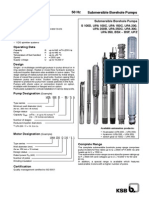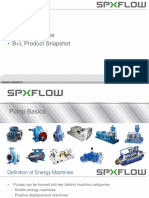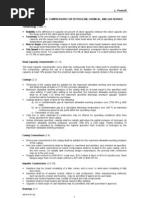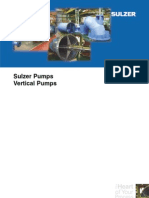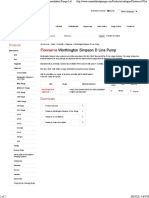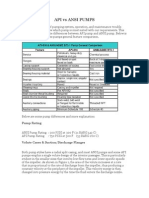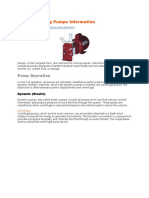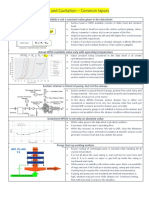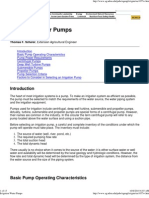Net Positive Suction Head Vs NPIP
Net Positive Suction Head Vs NPIP
Uploaded by
Shashi RaajCopyright:
Available Formats
Net Positive Suction Head Vs NPIP
Net Positive Suction Head Vs NPIP
Uploaded by
Shashi RaajCopyright
Available Formats
Share this document
Did you find this document useful?
Is this content inappropriate?
Copyright:
Available Formats
Net Positive Suction Head Vs NPIP
Net Positive Suction Head Vs NPIP
Uploaded by
Shashi RaajCopyright:
Available Formats
Net Positive Suction Head Versus Net Positive Inlet Pressure
Because centrifugal pumps and positive displacement pumps operate on entirely
different principles, common usage has created two different ways to identify the
pressures associated with them. In its simplest form, a centrifugal pump is a velocity
machine. The liquid to be pumped is directed into the center of a rotating impeller
where it is entrained in the impeller vanes and accelerated to a higher velocity. The
casing surrounding the impeller then converts the high velocity to pressure. Because it
is a velocity machine, if pressure is measured in units of liquid length, all units of
measure becomes consistent. Velocity is measured in meters/second (feet/second), and
pressure is measured in meters (feet), i.e., the pressure created by the height of a
column of the liquid being pumped. This consistent use of units greatly simplifies
pump calculations and allows the effects of certain liquid properties (specific gravity,
for example) to be ignored.
By contrast, a positive displacement pump does not generate pressure solely by
increasing fluid velocity. Instead, these pumps convert reciprocating motion and
torque into fluid motion and force, generating variable flow at the discharge
connection. This occurs as the pump cycles separately through each suction and
discharge stoke. Positive displacement pumps have no theoretical discharge pressure
limitation. They respond solely to the pumping system and require system discharge
pressure control, usually in the form of a relief valve, to prevent damage to the pump
mechanism and/or stalling of the driver. A centrifugal pump, however, responds quite
differently in that the discharge pressure developed is a function of flow through the
pump impeller. With decreasing flow (as in the case of increased system resistance),
the centrifugal pump develops an ever-increasing pressure rise up to the point defined
as shutoff head at zero flow. Shut-off head is the maximum pressure rise that a
centrifugal pump can develop.
For a reciprocating positive displacement pump, flow is a function of pump stroke
length and/or rpm. Either type of pump requires sufficient fluid pressure at the inlet to
prevent release of dissolved gasses and/or change of state of the pumped fluid from
liquid to gas. The term for pressure at the inlet is either Net Positive Suction Head
(NPSH) or Net Positive Inlet Pressure (NPIP). To be consistent, the API Standards for
both centrifugal and reciprocating pumps, as well as the latest editions of the
Hydraulic Institute Standards, refer to the total suction head as NPSH rather than
NPIP. Although the Hydraulic Institute indicates that NPSH is normally expressed in
either kPa (psi) or m (ft), the latest API Standards refer to NPSH in m (ft), the
preferred terminology for both pump types, to avoid confusion. Positive displacement
pump manufacturers generally refer to NPIP, expressed in kPa absolute (psi or bar,
absolute).
NPSH or NPIP is indicated as either Available or Required. The Net Positive Inlet
Pressure Available (NPIPA) is the absolute pressure above fluid vapor pressure at the
pump inlet and is determined as follows:
NPIPA = Pa + Pz – Pf – Pvp – Pamax (E.1)
where
Pa is the absolute pressure at surface of liquid in kPa absolute (psi or bar, absolute);
Pz is the static Head (+) or Static Lift (–) in kPa (psi) for level of fluid above or below
inlet;
Pf is the inlet line, valve & fitting friction losses at maximum viscosity in kPa (psi or
bar);
Pvp is the fluid vapor pressure or gas dissolution pressure in kPa absolute (psi or bar,
absolute);
Pamax is the pressure loss due to acceleration (see Pamax below) in kPa (psi or bar).
NPIPA calculation for a reciprocating controlled volume pump shall include the
effects of system acceleration head (see 3.3, acceleration pressure). From the
Hydraulics Institute Standards, Fourteenth Edition, liquid in the suction and
discharge lines of controlled volume pumps has to be accelerated because flow varies
with time. This produces alternate pressure drops and surges. The instantaneous
pressure drop required to accelerate the mass of fluid in the suction line, or the
instantaneous pressure rise required to accelerate the mass of fluid in the discharge, is
referred to as acceleration pressure. When computing this value for a reciprocating
controlled volume pump, the equation below defines the maximum instantaneous
value of hamax:
(E.2)
where
hamax is the maximum instantaneous acceleration head in meters (feet);
Pamax is the maximum instantaneous acceleration pressure in kPa (psi or bar);
L is the length of pipe in meters (feet);
C is 0.628 for simplex single-acting;
K is 1.4;
V is the average velocity in meter/sec (feet/sec);
n is the pump speed in rpm;
g is the gravitational constant, 9.82 m/s2 (32.2 ft/sec2).
NOTE: It is the responsibility of the Purchaser to define acceleration pressure, yet the
value is dependent on the characteristics of the pump selected. Consequently, the
value should be reviewed by both the Purchaser and the Vendor before a final
selection is made.
NPIP Required (NPIPR) is a function of pump type, speed, and viscosity of fluid
pumped. NPIP Available must always be greater than NPIPR to prevent occurrence of
cavitation. Typically, NPIPR values published by positive displacement pump
manufacturers are expressed in kPa (psi or bar) units. The preferred
means of communicating suction pressure requirements is: NPIP, NPIPA, and NPIPR.
Acceleration Pressure / Anticipated System Acceleration Pressure (3.3):
The estimated pressure changes due to changes in velocity in the piping system. It is
an important factor in the application of reciprocating pumps because of the pulsating
nature of the flow in the pump suction line, in addition to NPSHR, vapor pressure,
and pressure required to overcome suction line losses.
NOTE: This factor is accounted for in the standard calculation for NPIP. See the
definition of NPIP, NPIPa, and NPIPr.
Annex E (informative) API 675 3rd Edition
You might also like
- API 610 10th Edition (Iso 13709) Pump DatasheetDocument3 pagesAPI 610 10th Edition (Iso 13709) Pump DatasheetMuhammad Azka50% (4)
- Summary of API 610, 12th EditionDocument4 pagesSummary of API 610, 12th EditionTyas Utami88% (8)
- API 610 11th Edition (New Items)Document12 pagesAPI 610 11th Edition (New Items)Tirta Budiawan100% (4)
- BS en Iso 9905-1998+a1-2011Document72 pagesBS en Iso 9905-1998+a1-2011Tasawwur TahirNo ratings yet
- Spec For Centrifugal Pumps - APIDocument12 pagesSpec For Centrifugal Pumps - APIjowar100% (1)
- API-520 (Key Notes)Document5 pagesAPI-520 (Key Notes)nns_12100% (1)
- Understanding Centrifugal PumpDocument7 pagesUnderstanding Centrifugal PumpjokishNo ratings yet
- C C P DrawingDocument68 pagesC C P DrawinggangaghatNo ratings yet
- API 685 Vs API 610Document5 pagesAPI 685 Vs API 610sandeep100% (1)
- Iso 13631 Compresseur N 1Document7 pagesIso 13631 Compresseur N 1mostefa brahimiNo ratings yet
- Pump QuestionDocument7 pagesPump QuestionSandip KadoliNo ratings yet
- Specification For Horizontal End Suction Centrifugal Pumps For Chemical ProcessDocument30 pagesSpecification For Horizontal End Suction Centrifugal Pumps For Chemical ProcessFrancisco Gonzalez100% (2)
- API 610 12th EditionDocument7 pagesAPI 610 12th EditionmuhammedNo ratings yet
- Guidelines 0n Pump Vibration First Edition Final July 2013Document5 pagesGuidelines 0n Pump Vibration First Edition Final July 2013Theophilus ThistlerNo ratings yet
- Arranging Dissimilar Centrifugal Pumps in Series and ParallelDocument8 pagesArranging Dissimilar Centrifugal Pumps in Series and ParallelPujo BagusNo ratings yet
- HPX Oh2 Api610 New enDocument8 pagesHPX Oh2 Api610 New enAlexander RivillasNo ratings yet
- API 610 PumpsDocument8 pagesAPI 610 PumpsSaurabh Singh67% (3)
- Operating Pumps in ParallelDocument3 pagesOperating Pumps in Paralleldk4monjure100% (1)
- Submersible Borehole Pumps - 50 HZDocument118 pagesSubmersible Borehole Pumps - 50 HZanirbanpwd76No ratings yet
- API 614-Chapter 2 DATA SHEET Special Purpose Oil System Si UnitsDocument7 pagesAPI 614-Chapter 2 DATA SHEET Special Purpose Oil System Si UnitstutuionutNo ratings yet
- Api 675 Metering Pump WorkshopDocument67 pagesApi 675 Metering Pump WorkshopBalinderjit SinghNo ratings yet
- Pumpapi675presentation 150805065440 Lva1 App6891 PDFDocument42 pagesPumpapi675presentation 150805065440 Lva1 App6891 PDFsanthoshkumarpl100% (1)
- API610 Pump Selection 06 2016Document42 pagesAPI610 Pump Selection 06 2016Orkhan GaniyevNo ratings yet
- API 676 Datasheet PDFDocument6 pagesAPI 676 Datasheet PDFPierre Norris0% (1)
- API 610 - High LightsDocument9 pagesAPI 610 - High LightsVel MuruganNo ratings yet
- Acceleration Head For Reciprocating PumpsDocument2 pagesAcceleration Head For Reciprocating PumpsEng Alf100% (3)
- Concrete Volute PumpsDocument8 pagesConcrete Volute PumpsvijayunityNo ratings yet
- 1 - Pump BasicDocument46 pages1 - Pump Basicriin100% (1)
- API 610 ConclusionsDocument4 pagesAPI 610 ConclusionsSittigorn PongsawatmanitNo ratings yet
- Presentación de Normas de BombasDocument18 pagesPresentación de Normas de BombasP_I_P_HNo ratings yet
- Low NPSH & Cases of Vertical Barrel (VS6) Type Pump Selection PDFDocument12 pagesLow NPSH & Cases of Vertical Barrel (VS6) Type Pump Selection PDFMuhammad ImranNo ratings yet
- API 610 Pump Selection and Curve EvaluationDocument4 pagesAPI 610 Pump Selection and Curve Evaluationbbmoksh100% (1)
- Preview of API 610 12th EditionDocument7 pagesPreview of API 610 12th EditionHatem ShawkiNo ratings yet
- Api 617Document7 pagesApi 617Sean_Middleton100% (1)
- Mechanical Data Sheet For Centrifugal Pumps (P-1203A/B) : Poly Butadiene II (35000 TPY)Document7 pagesMechanical Data Sheet For Centrifugal Pumps (P-1203A/B) : Poly Butadiene II (35000 TPY)you kackNo ratings yet
- Factory Performance Testing of Vertical Turbine PumpsDocument3 pagesFactory Performance Testing of Vertical Turbine PumpsSrećko BlaževićNo ratings yet
- BB3 Vs BB5Document10 pagesBB3 Vs BB5kambleyog100% (1)
- MEP M ES 012 - Centrifugal Process Pumps To API 610Document26 pagesMEP M ES 012 - Centrifugal Process Pumps To API 610Anonymous wIPMQ5rh100% (1)
- Suction Specific SpeedDocument11 pagesSuction Specific Speeddhanu_aqua100% (1)
- API 610 11th Ed DatasheetDocument13 pagesAPI 610 11th Ed DatasheetHatem ShawkiNo ratings yet
- Vertical PumpsDocument16 pagesVertical PumpsAdel Shatla100% (1)
- Process Industry Practices Machinery: Pip Resp73H Application of ASME B73.1 - 2001Document15 pagesProcess Industry Practices Machinery: Pip Resp73H Application of ASME B73.1 - 2001m4metzNo ratings yet
- Summary of API 610 12th EditionDocument4 pagesSummary of API 610 12th EditionYang Kyo OhNo ratings yet
- Acceptance Tests of Centrifugal PumpsDocument20 pagesAcceptance Tests of Centrifugal PumpsAndrés Barón100% (1)
- Fehniger Steve-Pump Vibration UnlockedDocument35 pagesFehniger Steve-Pump Vibration Unlockedreynaldo figueroa guerreroNo ratings yet
- Flowserve Worthington Simpson D Line PumpDocument2 pagesFlowserve Worthington Simpson D Line PumpronggoNo ratings yet
- API Pump TheoryDocument31 pagesAPI Pump TheoryFidezuri Yemen83% (6)
- Cryogenic Pumps EnglishDocument12 pagesCryogenic Pumps EnglishbruherNo ratings yet
- API Vs ANSI PumpsDocument6 pagesAPI Vs ANSI PumpsRS100% (2)
- Norsok Standard - Mechanical Equipment SelectionDocument17 pagesNorsok Standard - Mechanical Equipment SelectionBudi IndraNo ratings yet
- Libro de BombasDocument260 pagesLibro de BombasBoris SalazarNo ratings yet
- GPM RevDocument138 pagesGPM RevJuan Cortes TorizNo ratings yet
- Centrifugal Pump - HandbookDocument26 pagesCentrifugal Pump - HandbookPrafull Dhakate100% (3)
- Centrifugal Pump Sizing, Selection and Design Practices (Hay)Document77 pagesCentrifugal Pump Sizing, Selection and Design Practices (Hay)Scribd_del83% (12)
- Reciprocating Pump CatalogDocument109 pagesReciprocating Pump Catalogmetasoniko2014100% (2)
- NPSH For Metering PumpsDocument7 pagesNPSH For Metering PumpsRahul S. Chandrawar100% (2)
- Centrifugal PumpDocument23 pagesCentrifugal Pumpheri monawir zebua100% (1)
- A-1 Head: Section A - Centrifugal Pump FundamentalsDocument18 pagesA-1 Head: Section A - Centrifugal Pump FundamentalsReNyy Chow100% (1)
- 5.2 What Are The Characteristics of A Centrifugal PumpDocument12 pages5.2 What Are The Characteristics of A Centrifugal PumpmohanrajpandiarajanNo ratings yet
- Liquid Handling Pumps InformationDocument15 pagesLiquid Handling Pumps InformationtowiwaNo ratings yet
- Transportation of Fluids: Prepared By: Engr. Joseph R. OrteneroDocument48 pagesTransportation of Fluids: Prepared By: Engr. Joseph R. OrteneroChristianNo ratings yet
- DPV 50 HZ Vertical Pumps Technical DataDocument92 pagesDPV 50 HZ Vertical Pumps Technical DataEugenia BondarenkoNo ratings yet
- KSB Vertical PumpDocument6 pagesKSB Vertical PumpVictor Gabriel MagcalingNo ratings yet
- GRUNDFOS - Pump HandbookDocument157 pagesGRUNDFOS - Pump Handbookrdavid@hotmail.it97% (29)
- Pump Calculation Basic Pump DataDocument2 pagesPump Calculation Basic Pump DataAJAY1381No ratings yet
- Controlled Volume Pump (Api 675-2Nd) Data Sheet U.S. Customary UnitsDocument3 pagesControlled Volume Pump (Api 675-2Nd) Data Sheet U.S. Customary UnitshamedNo ratings yet
- Matrix Booster PumpDocument26 pagesMatrix Booster PumpWissam JarmakNo ratings yet
- Tubewell Energy Audit11Document174 pagesTubewell Energy Audit11vehicles.detectionNo ratings yet
- Lab 2 Centrifugal PumpsDocument29 pagesLab 2 Centrifugal PumpslalelaNo ratings yet
- Technical OfferDocument50 pagesTechnical OfferHisham ElsayedNo ratings yet
- Tds Ns HMR 74419 Item2 RKB 40 14h 16stg 45kc2 427m 18m3 15 06 2023Document1 pageTds Ns HMR 74419 Item2 RKB 40 14h 16stg 45kc2 427m 18m3 15 06 2023neerajNo ratings yet
- Flsmidth Slurry PumpDocument67 pagesFlsmidth Slurry PumprvkheavenNo ratings yet
- Centrifugal Pumps - Suction Specific SpeedDocument28 pagesCentrifugal Pumps - Suction Specific Speedhadiveyse.operationNo ratings yet
- NPSH and CavitationDocument1 pageNPSH and CavitationSofiane HalimiNo ratings yet
- Project - Report - On - Ammonia - Mechanical by Mridul JainDocument39 pagesProject - Report - On - Ammonia - Mechanical by Mridul JainShivani DhakadNo ratings yet
- Curve Hot Water Return Pump 7-8 96556828 - CR - 59 - AAAEHQQEDocument8 pagesCurve Hot Water Return Pump 7-8 96556828 - CR - 59 - AAAEHQQEForhad AhmedNo ratings yet
- Submergence Necessary For Pump Storage Power Plant Turbines PDFDocument4 pagesSubmergence Necessary For Pump Storage Power Plant Turbines PDFSunil MaharjanNo ratings yet
- Transport Phenomena 1Document20 pagesTransport Phenomena 1Kaify PeshmergaNo ratings yet
- Class 1: Pttep International Limited (Myanmar) Zawtika Development ProjectDocument10 pagesClass 1: Pttep International Limited (Myanmar) Zawtika Development ProjectfajarNo ratings yet
- Irrigation Water PumpsDocument13 pagesIrrigation Water Pumpshhghgh0% (1)
- Che 411A: Fluid Mechanics: Sourc E TopicDocument24 pagesChe 411A: Fluid Mechanics: Sourc E TopicChristine Mae Vea100% (1)
- Datasheet ZE 150-500Document1 pageDatasheet ZE 150-500Rahmat Budi HartantoNo ratings yet
- Technical Documents 8787Document459 pagesTechnical Documents 8787Anonymous 3akQhQFJSL100% (1)
- Manufacturing Range En-2012Document32 pagesManufacturing Range En-2012mmihai_popa200650% (2)
- SRZS New Brochure 4-3-18Document3 pagesSRZS New Brochure 4-3-18Mohamed Abd RahmanNo ratings yet
- Pump Calculation: Date of Calculation SignatureDocument5 pagesPump Calculation: Date of Calculation SignaturesyaifulRizal12345678No ratings yet
- Pumps - 1Document9 pagesPumps - 1PrashantNo ratings yet
- High Speed High Pumping Systems: WilsonDocument49 pagesHigh Speed High Pumping Systems: WilsonShankar PediredlaNo ratings yet
- L, LV Fire and Bilge PumpsDocument48 pagesL, LV Fire and Bilge PumpsA SchonseeNo ratings yet
- Ruhrpumpen Pumps For Water and WastewaterDocument8 pagesRuhrpumpen Pumps For Water and WastewaterJuliano Patricio NogueiraNo ratings yet


















